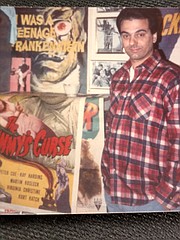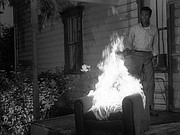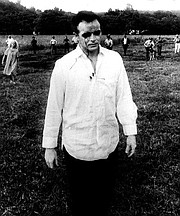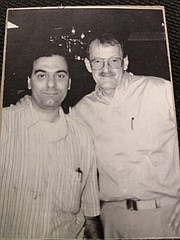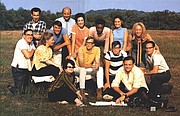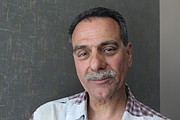A DAY with the DEAD
Devin Heilman Staff Writer | Hagadone News Network | UPDATED 8 years, 6 months AGO
It must have been strange to hear Bob Lind's sweet "Elusive Butterfly" play from transistor radios as simulated gunfire sprayed toward a horde of the undead.
"I watched the zombies walking toward the camera and a helicopter flying above, shooting at the zombies as this beautiful song played," Paul Parla said. "The surreal lyrics of the song played out in an interesting way, and when you're 13 years old, lasting impressions have a way of remaining with you."
Parla, of Coeur d'Alene, was on set during the action-packed night scene of the zombie movie that changed everything — George A. Romero's original "Night of the Living Dead."
“The field shots I remember,” Parla said. “I remember the German shepherd dogs, I remember them getting out of the car ... there was a police car in the front and off to the right, up on a little hillside, there’s guys with tripod cameras shooting the dog jumping out of the police car.
"I don't believe I took a camera that day," he said. "That would have been nice."
"Night of the Living Dead" began filming 50 years ago this month. Filming took place in rural Pennsylvania from June to December 1967 and the movie premiered Oct. 1, 1968.
"When I first saw 'Night of the Living Dead' at the Royal Theater in Bloomfield, N.J. around 1968-1969, the film truly unnerved me because of the raw realism and somewhat convincing style they used to shoot it," Parla said. "Being there when they filmed some of the scenes and then seeing it on the screen was like night and day."
He said even though he was behind the scenes of this iconic film, to see it on the big screen was really scary.
"It simply terrified me," he said. "Children were terrified, screaming, some fainting. Up until this point, kids were used to seeing the camp horror films like 'The Wolfman,' 'Attack Of The Giant Leeches,' 'The Wasp Woman' at the horror matinees. But when 'Night' debuted, it was sheer terror in the theaters."
Parla, who grew up in Newark, N.J., had two second cousins who were asked to be in the film because they knew Romero and co-writer John A. Russo through friends of friends. The cousins, brothers Mark and R.J. Ricci, were cast as members of the living dead. Mark also had a brief appearance as a news reporter in Washington, D.C.
“When you see it happen, you’re just there for that one day of the shoot," Parla said, his Jersey accent still distinctive. "When you see the whole movie, (you think) ‘Well, it didn’t feel that way when I saw it (on set),’ but it still felt that way when I got home. It touched a raw nerve."
Parla said "Night" entered the scene at a pivotal time in America. The fictional violence depicted in the film — the shooting, especially — reflected the actual violence that was occurring around the country. Parla recalls race riots happening in his neighborhood and waking up to Army tanks rolling down his street.
"In the movie a person’s body became something for the fire," he said. “I was seeing that in Newark, I was seeing it in the riots, people getting picked off. Not (necessarily) seeing it happen, but sort of hearing the gunfire, seeing the guys with the rifles and all, and what was happening to the black kids at that time. They were just literally shooting kids off their bikes because they were throwing Molotov cocktails. They were rioting down the street, and they weren’t going to stand for that, at least the people in my area were not going to stand for it."
"Night" sparked its own controversies. It was the first time an African-American was cast as the hero, but Romero has said in interviews that Duane Jones "simply gave the best audition."
“It was a very turbulent time in the country," Parla said. “In ’68 it was even worse because everybody had just lost hope for everything. Bobby Kennedy, Martin Luther King were shot, riots erupting from at least ’64 to '65-'66-'67 all over the country, the drug culture was coming in, which people did not like whatsoever."
He said it seemed like things changed overnight; one day it was Frankie Valli and the Four Seasons on the radio, the next it was Jimi Hendrix and Janis Joplin.
"It was like they were just waiting," he said. "You had all this thrown out into the airwaves. We still had Frankie Valli and the pop, but yet we had the psychedelic mixed in ... Things were changing so fast, and not so much for the better, but society was changing. We were seeing images on television that we were not seeing just a few years before. It was kind of shocking."
Parla's cousin Mark opened a movie collection store, the Memory Shop, in New York City where Parla visited all the time. Parla became a substantial collector of monster movie posters and memorabilia and went on to co-author "Screen Sirens Scream," a collection of interviews with leading ladies of early horror films.
He credits his cousin's role in "Night" and curious collection shop with cultivating a love of the sci-fi horror genre, a genre that was never the same after "Night of the Living Dead" tested the boundaries and scared the daylights out of unsuspecting audiences.
"I love and appreciate black and white, mood and shadow," he said. "It’s the black and white that really does it, and that’s what really did it for me with that movie. The black and white, in a sense, added to a whole lot of the other aspects."
Parla learned some interesting facts about the film, on set and later. Bosco Chocolate Syrup was used as blood. The newscasts in the movie had a "War of the Worlds"-type effect on some people who thought they were real if they hadn't been watching the film up to that point.
He said the Kecksburg UFO incident that occurred in 1965, where rural Pennsylvania residents reported seeing something crash to Earth from space (giving the area the nickname "Pennsylvania Roswell"), may have served as inspiration for the story of the dead coming back to life.
And he learned that even beautiful actresses can make terrifying zombies.
“I hung around Marilyn (Eastman) a lot because she was doing make-up,” Parla said. “She goes, ‘I’m going to be a zombie too.’ I remember her saying that. Later on when I saw the movie, I go, ‘There’s Marilyn, eating the insect off the tree.’
"'Night' was the zombie movie that changed the face of horror films," he said. "'Night' is a horror film with varied psychological levels and that is just one of the reasons why it has such longevity."
ARTICLES BY DEVIN HEILMAN STAFF WRITER

Dear Vietnam vets, Bayview wants you
BAYVIEW — Dear Vietnam veterans: The queen is requesting your presence.

Coeur d'Con: Where universes collide
COEUR d’ALENE — It's not every day a badger-dragon battles a knight on the Coeur d'Alene Public Library's lawn.
NEA official: Progressive uprising is on the horizon
HAYDEN LAKE — America is on the brink of revolution.










